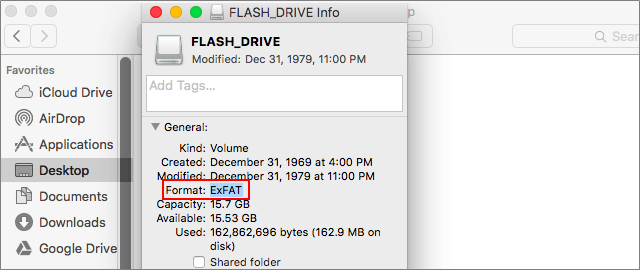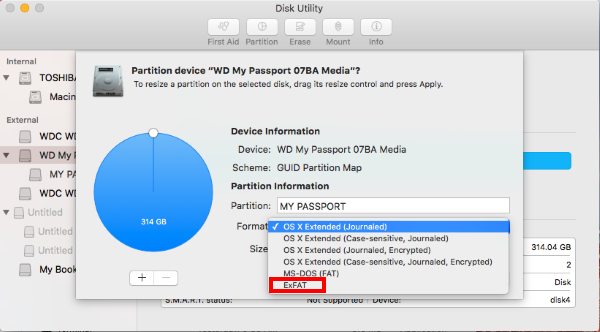
Formatting A Drive For Both Mac And Windows Using Ex-fat
A Western Digital external hard drive can be used on both Windows and macOS. File and partition size limitations using the FAT32 file system (Windows and Mac). The easiest way to format the drive to FAT32 or ExFAT is by using macOS's. Format drive exFAT in Windows 10 using Command Prompt. It is quite easy to have exFAT format in Windows 10, isn’t it? It worth mentioning that Windows 10 has built-in formatting tools as well, Disk Management and Diskpart. If right click a particular drive in Windows 10 File Explorer, you can format the drive to exFAT directly as well.
Whether you’re formatting an internal drive, external drive, USB flash drive, or SD card, Windows gives you the choice of using three different file systems: NTFS, FAT32, and exFAT. The Format dialog in Windows doesn’t explain the difference, so we will. RELATED: A provides a way of organizing a drive. It specifies how data is stored on the drive and what types of information can be attached to files—filenames, permissions, and other attributes. Windows supports three different file systems. NTFS is the most modern file system.
Windows uses NTFS for its system drive and, by default, for most non-removable drives. FAT32 is an older file system that’s not as efficient as NTFS and doesn’t support as big a feature set, but does offer greater compatibility with other operating systems. ExFAT is a modern replacement for FAT32—and more devices and operating systems support it than NTFS—but it’s not nearly as widespread as FAT32.
NT File System (NTFS) NTFS is the modern file system Windows likes to use by default. When you install Windows, it formats your system drive with the NTFS file system. NTFS has file size and partition size limits that are so theoretically huge you won’t run up against them. NTFS first appeared in consumer versions of Windows with Windows XP, though it originally debuted with Windows NT. NTFS is packed with modern features not available to FAT32 and exFAT. NTFS supports file permissions for security, a change journal that can help quickly recover errors if your computer crashes, shadow copies for backups, encryption, disk quota limits, hard links, and various other features. Many of these are crucial for an operating system drive—especially file permissions.
Your Windows system partition must be NTFS. If you have a secondary drive alongside Windows and you plan on installing programs to it, you should probably go ahead and make it NTFS, too. And, if you have any drives where compatibility isn’t really an issue—because you know you’ll just be using them on Windows systems—go ahead and choose NTFS. RELATED: Despite its advantages, where NTFS lacks is compatibility. It’ll work with all recent versions of Windows—all the way back to Windows XP—but it has limited compatibility with other operating systems. By default, Mac OS X can only read NTFS drives, not.
Some Linux distributions may enable NTFS-writing support, but some may be read-only. None of Sony’s PlayStation consoles support NTFS. Even Microsoft’s own Xbox 360 can’t read NTFS drives, although the new Xbox One can. Other devices are even less likely to support NTFS. Compatibility: Works with all versions of Windows, but read-only with Mac by default, and may be read-only by default with some Linux distributions. Other devices—with the exception of Microsoft’s Xbox One—probably won’t support NTFS.
Limits: No realistic file-size or partition size limits. Ideal Use: Use it for your Windows system drive and other internal drives that will just be used with Windows. File Allocation Table 32 (FAT32) FAT32 is the oldest of the three file systems available to Windows. It was introduced all the way back in Windows 95 to replace the older FAT16 file system used in MS-DOS and Windows 3.
RELATED: The FAT32 file system’s age has advantages and disadvantages. The big advantages is that because it’s so old, FAT32 is the de-facto standard. For maximum compatibility across not just modern computers, but other devices like game consoles and anything with a USB port. Limitations come with that age, however. Individual files on a FAT32 drive can’t be over 4 GB in size—that’s the maximum. A FAT32 partition must also be less than 8 TB, which admittedly is less of a limitation unless you’re using super-high-capacity drives. While FAT32 is okay for USB flash drives and other external media—especially if you know you’ll be using them on anything other than Windows PCs—you won’t want to FAT32 for an internal drive. It lacks the permissions and other security features built into the more modern NTFS file system.
Also, modern versions of Windows can no longer be installed to a drive formatted with FAT32; they must be installed to drives formatted with NTFS. Compatibility: Works with all versions of Windows, Mac, Linux, game consoles, and practically anything with a USB port. Pip install lxml for python 3 mac torrent.
Limits: 4 GB maximum file size, 8 TB maximum partition size. Ideal Use: Use it on removable drives where you need maximum compatibility with the widest range of devices, assuming you don’t have any files 4 GB or larger in size. Extended File Allocation Table (exFAT) RELATED: The exFAT file system was introduced in 2006 and was added to older versions of Windows with updates to Windows XP and Windows Vista. ExFAT is —designed to be a lightweight file system like FAT32, but without the extra features and over head of NTFS and without the limitations of FAT32. Like NTFS, exFAT has very large limits on file and partition sizes., allowing you to store files much larger than the 4 GB allowed by FAT32. While exFAT doesn’t quite match FAT32’s compatibility, it is more widely-compatible than NTFS.
While Mac OS X includes only read-only support for NTFS, Macs offer full read-write support for exFAT. ExFAT drives can be accessed on Linux by installing the appropriate software. Devices can be a bit of a mixed bag. The PlayStation 4 supports exFAT; the PlayStation 3 does not. The Xbox One supports it, but the Xbox 360 does not. Compatibility: Works with all versions of Windows and modern versions of Mac OS X, but requires additional software on Linux. More devices support exFAT than support NTFS, but some—particularly older ones—may only support FAT32.
Limits: No realistic file-size or partition-size limits. Ideal Use: Use it when you need bigger file size and partition limits than FAT32 offers and when you need more compatibility than NTFS offers. Assuming that every device you want to use the drive with supports exFAT, you should format your device with exFAT instead of FAT32. NTFS is ideal for internal drives, while exFAT is generally ideal for flash drives.
However, you may sometimes need to format an external drive with FAT32 if exFAT isn’t supported on a device you need to use it with.
You can format your external hard drive from either the PC or Mac. Just keep in mind if you want to use your drive also for OS X’s Time Machine backups, we advise you to format your drive through Mac because there is an additional step to make drive compatible with “Time Machine Backups”. And you can only do this with exFAT as with FAT32 Mac OS X’s Time Machine backup won’t work. FAT32 or exFAT? You can format your external hard drive in both – exFAT and FAT32. They both will work just fine.
Mac and PC can read and write on both. However, each of these filesystems has their own pros and cons. FAT32 has a maximum 4GB file size limit, but exFAT can work with files as large as 16EB, that’s more than you will ever need.
If you have to work with large video clips, games or any other kind of massive files, FAT32 may not be the best choice. Many still choose FAT32 over exFAT despite its slower performance, as it’s also compatible with Linux Os and is supported on many consoles.
Once you have done with formatting, your external hard drive will be able to write and read files from both a PC and Mac. The resulting FAT32 file system will be compatible with all versions of Mac OS X, and Windows including back to 95.
This is one of the most widely recognized file system formats. FAT32 – a file system normally used on USB disks. exFAT – a newer file system optimized for flash devices and has improved performance overFAT32 Why I can’t use NTFS on Mac? The default file system for Windows is NTFS (New Technology File System).
Macs that run Snow Leopard or Lion can read data from drives that are formatted as NTFS. However, they can’t write. To make your Mac compatible writing on NTFS you have to get and install a third-party driver. So in the end, it’s possible to make your NTFS external hard drive compatible with Mac. But we advise to just format it to “FAT” file system as it’s less time consuming and easier.
Windows 7 can’t read nor write files to external drives that are formatted as HFS. To do so you also have to install third-party like.
How to format an External Drive in Windows 1) Connect the drive to your Windows PC. 2) Open Disk Management.
3) Right click on unallocated or any other disk partition and select “ New Simple Volume” 4) Choose your desired size 5) Assign your external hard drive with any letter. 6) Choose exFAT as the file system.
7) Follow the instructions and at the end click “ Finish“ How to Format an External Drive in OS X 1) Connect your external hard drive to the Mac. 2) Open Disk Utility. You can do this quickly by pressing CMD and the spacebar at the same time. Then type in “Disk Utility”. 3) Select the drive you want to format. 4) Click the Partition tab.
6) Change the Partition Layout from Current to 1 Partition. 7) Click Options, Select Master Boot Record, and click OK. 8) Name the hard drive with a name of your choice.
9) Click the Format drop-down menu. 10) Select exFAT or MS-DOS FAT(FAT32). 11) At last press Apply, then click on Partition. WD My Book would be best for desktop, Seagate Backup Plus Slim would be one of the best portable hard drives. Both are all-around decent drives and will do fine for any backup, pictures included. As for cross-platform encryption, if you intend to use the same drive on both Mac and Windows, the best option would be using a cross-platform compatible encryption tool, like, while formatting the drive in exFAT to avoid compatibility issues. This is because Windows won’t recognize Mac’s native encryption and vice versa.

VeraCrypt is well-renowned, so it should function well without any problems, just be prepared to learn how to use the tool. Try testing this setup with just a couple files before you perform entire backups.